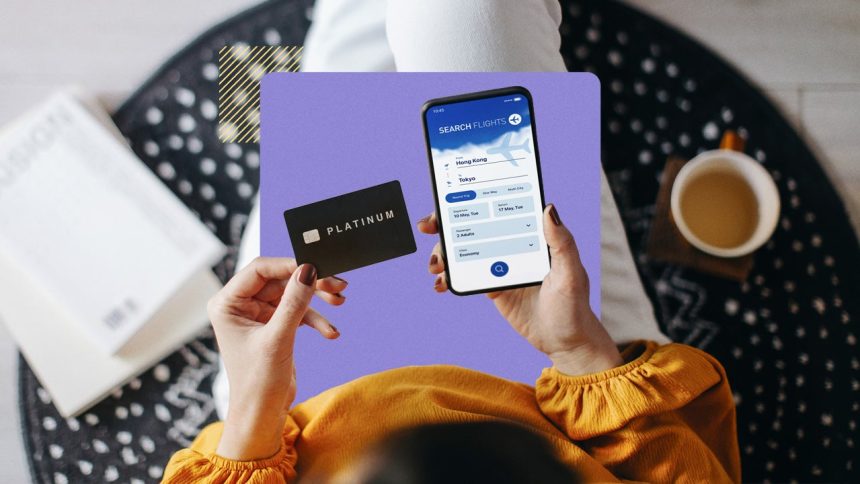d3sign/Getty Images: Illustration by Issiah Davis/Bankrate
Key takeaways
- Impulse buying with a credit card is fun today, but can lead to overspending and credit card debt tomorrow.
- Access to credit and social media are two common factors for impulse buying.
- By taking steps like budgeting, following the 24-hour rule and not shopping on your phone, you can regain control over impulse purchases.
If you’ve ever spontaneously bought makeup or a desk chair (guilty!) while scrolling social media or dropped several hundred dollars on a limited-edition pair of Nikes, you might be impulse buying with a credit card.
But while you’re dreaming of how much better your skin, outfit or Instagram will look with that new product, your wallet is crying out for help.
“Purchasing fun or recreational items can trigger the brain’s reward center,” says Grant Gallagher, director of financial wellbeing and brand communications at Affinity Federal Credit Union. “Many impulse buyers either don’t consider the future impact of these purchases or assume they will figure it out later, getting caught up in the moment of the purchase.”
The emotional side of your brain can very easily overcome the rational.
— Grant Gallagher
Director of financial wellbeing and brand communications at Affinity Federal Credit Union
Learn how credit cards and impulse buying can go hand in hand — and how to not fall victim to this common trap.
How credit cards can lead to impulse buying
Like most types of unhealthy spending, impulse purchases usually have a deeper motivation. As a Certified Credit Counselor, I’ve learned most spenders fit into one of seven types:
- Fanatical shoppers: Obsessed with getting the lowest price
- Passive spenders: Persuaded by ads or salespeople to buy things they don’t need
- Ulterior motive spenders: Escaping a certain emotion or stress, or doom spending
- Esteem spenders: Keeping up with the Joneses
- Special interest spenders: Funding an expensive hobby or addiction
- Hot potato spenders: Procrastinating on a big purchase until they can’t stand the pressure anymore and quickly making the purchase
- Impulsive spenders: Don’t plan before they shop and often end up with things they don’t need
The categories above can overlap, especially when it comes to impulse buying. You might buy an item spontaneously because it’s on sale or you tasted a sample at the store. Or you might spend more at brunch than you planned because your friends are ordering another round of mimosas.
A few everyday examples of impulse purchases with a credit card could include:
- Skincare products promoted by a social media influencer
- Grocery items that weren’t on the shopping list
- Limited-edition sneakers or merchandise that was just released
- An all-inclusive resort stay you saw on Groupon
- Takeout even though dinner ingredients are in the fridge
- A purse or coat you saw while you were supposed to only be window shopping
- An electronic device that comes with a buy now, pay later plan
Impulse buying with a credit card is risky — here’s why
The risk of impulse buying is that it throws your budget out of whack. Say you’ve allocated $500 for monthly groceries. But every time you grocery shop, you toss last-minute snacks in the cart that weren’t on the list.
Now, your grocery bills add up to $700, and that extra $200 has to come from somewhere else. It might cut into your savings or debt repayment. Or, if you put all your bills on a credit card, you may end up carrying a balance and accruing interest.
Still, 16 percent said in Bankrate’s 2025 Money and Mental Health Survey they’d bought an unplanned, nonessential item in just the last month. And 48 percent of social media users said in Bankrate’s 2023 Social Media Survey they’ve impulsively bought a product they saw on social media.
Credit card interest rates are high, making impulse buying an expensive habit. Yet nearly half of Americans carry credit card debt month to month, according to Bankrate’s Credit Card Debt Report. If you continue carrying a balance and even adding to it with more impulse purchases, those interest charges can lead to debt that spirals out of control.
“As impulse buying becomes a trend in your everyday life, the debt further accumulates,” says Gallagher. This can leave you with “high credit card bills, forcing you to try opening new credit cards or extending your credit limit to purchase even more.”
Social media is no longer just for sharing snippets of your life and keeping up with friends’ vacations, birthdays or babies. It’s also become an advertising machine.
Sprout Social reports that around half of consumers (48 percent) interact with brands on social media more often today than they did six months ago. And brands spend an average of $46.47 to reach you — a social media user.
Even more persuasive are social media influencers, or people we follow for their lifestyle, expertise or other content. Those influencers are often paid by brands to promote products. Nearly half of consumers (49 percent) make influencer-promoted purchases at least once a month. And the market is expected to be worth $32.55 billion in 2025.
With all these products at your fingertips, it’s easy to enter or autofill your credit card number and get a package on your doorstep a few days later. In fact, Bankrate found that impulse shoppers on social media spent an average of $754 a year.
But among those who’ve made impulse purchases on social media, around 2 in 3 (68 percent) regretted at least one purchase.
5 ways to stop impulse buying with a credit card
If you want to stop making purchases on a whim, this is your sign. Here are five steps to avoid impulse buying with a credit card.
- Set a budget and stick to it. A monthly budget is a must-have. It doesn’t have to be a complicated spreadsheet — there are apps for that — but it should at least track where your income is going so you can reach your financial goals. A budget will help you notice if impulse buying is causing you to overspend in certain budget categories.
- Wait 24 hours. The 24-hour rule suggests waiting a full day after seeing something you want before buying it. During that time, consider whether you really need it and compare alternative options and prices. You can also take a look at your budget to see whether this purchase fits into your monthly spending. After 24 hours, you may no longer need or want the item.
- Don’t shop on your phone. If you end up on TikTok Shop, Like to Know It (LTK) or Amazon during your daily scroll, delete those apps. Don’t save your credit card information for autofill. You can even unfollow influencers who make you feel most tempted to buy things you don’t need.
- Try the “no-buy” challenge. Some people are participating in the new no-buy trend, which is when you make no discretionary purchases for a set amount of time. To start small, you could try buying no takeout for a week or no new clothes for a month. Over time, you may find yourself saving money and adopting new habits. As one Redditor said recently on the /nobuy thread,* “I have avoided making frivolous purchases and have been tracking my spending. With that said, so far I have saved almost $3,000 [by] not buying junk and sticking to my low buy rules!”
- Take a personal finance course or work with a credit counselor. It can be easier to stay on top of your finances with professional guidance. There are a number of free or low-cost personal finance courses online. You could also enlist the help of nonprofit credit counseling, which helps people get out of debt and follow a spending plan. In the meantime, find free advice on Bankrate about credit cards, building your credit score and more from Certified Credit Counselors like myself and several of my colleagues.
The bottom line
Before heading to checkout for an impulse buy, Gallagher says to ask yourself these questions:
- “Why do I want this?
- How many times will I use this product or service?
- Can I pay this off on my credit card bill at the end of the month?
- Will I regret buying this?”
By resisting overconsumption and sticking to a budget — along with the other tips above — you can stop impulse buying with a credit card. And that sense of control is something money can’t buy.
*The quotes and citations included on this page have been verified by our editorial team and are accurate as of the posting date. Outlinked content may contain views and opinions that do not reflect the views and opinions of Bankrate.
Read the full article here
















